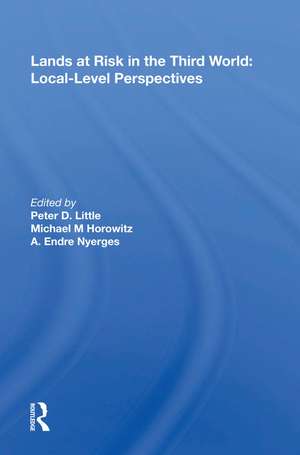Lands At Risk In The Third World: Local-level Perspectives
Autor Peter D. Littleen Limba Engleză Hardback – 7 iun 2019
Preț: 764.20 lei
Preț vechi: 1027.40 lei
-26% Nou
Puncte Express: 1146
Preț estimativ în valută:
146.25€ • 152.49$ • 121.54£
146.25€ • 152.49$ • 121.54£
Carte tipărită la comandă
Livrare economică 21 martie-04 aprilie
Preluare comenzi: 021 569.72.76
Specificații
ISBN-13: 9780367012205
ISBN-10: 0367012200
Pagini: 430
Dimensiuni: 152 x 229 mm
Greutate: 0.45 kg
Ediția:1
Editura: Taylor & Francis
Colecția Routledge
Locul publicării:Oxford, United Kingdom
ISBN-10: 0367012200
Pagini: 430
Dimensiuni: 152 x 229 mm
Greutate: 0.45 kg
Ediția:1
Editura: Taylor & Francis
Colecția Routledge
Locul publicării:Oxford, United Kingdom
Cuprins
Monographs in Development Anthropology -- Foreword -- Introduction: Social Science Perspectives on Land, Ecology, and Development -- Models of Resource Management -- Labor Scarcity and Ecological Change -- The “Political Ecology” of Amazonia -- Insiders and Outsiders in Baluchistan: Western and Indigenous Perspectives on Ecology and Development -- Monitoring Fertility Degradation of Agricultural Lands in the Lowland Tropics1 -- The Role of the State -- The Political Economy of Desertification in White Nile Province, Sudan1 -- Impact of Fuelwood Use on Environmental Degradation in the Sudan1 -- Bringing Land Back In: Changing Strategies to Improve Agricultural Production in the West African Sahel1 -- Unequal Exchange: The Dynamics of Settler Impoverishment and Environmental Destruction in Lowland Bolivia1 -- Changing Rights to Land and Other Resources -- Land Use Conflicts in the Agricultural/Pastoral Borderlands: The Case of Kenya -- Ecology and Land Use Changes in the Semiarid Zone of the Sudan -- The Politics of Lands at Risk in a Philippine Frontier1 -- Lands at Risk, People at Risk: Perspectives on Tropical Forest Transformations in the Philippines -- Local Management Strategies -- Diversity and Change in Andean Agriculture1 -- Intensification and Degradation in the Agricultural Systems of the Peruvian Upper Jungle: The Upper Huallaga Case1 -- The Development Potential of the Guinea Savanna: Social and Ecological Constraints in the West African “Middle Belt”1 -- Rehabilitation Efforts and Household Production Strategies: The New Halfa Agricultural Scheme in Eastern Sudan -- The Local Impact of Centralized Irrigation Control in Pakistan: A Sociocentric Perspective1 -- Conservation and Society in Nepal: Traditional Forest Management and Innovative Development1
Descriere
This book presents important case studies highlighting social, economic, political, and biological dimensions of environmental degradation in the Third World. Focusing on areas identified as experiencing or at risk for deterioration, the studies are drawn from nearly every continent and cover most of the larger ecosystems of the Third World, including arid and semiarid rangelands, tropical rain forests, steep-sloped mountains and hills, tropical river basins, and coastal lowlands. The authors use local data to examine, test, and refine larger explanatory models and theories, showing how comparisons of case-specific data can sharpen our knowledge about resource use in areas at risk. In doing so, the authors address two critical questions: How can land degradation processes be identified and how can the human role in land degradation be separated from the effects of climate and other natural actions?
